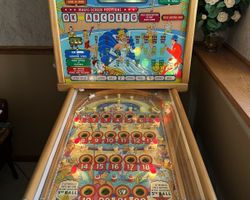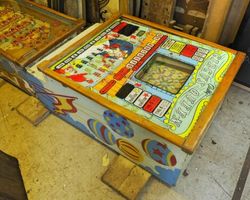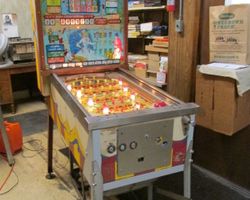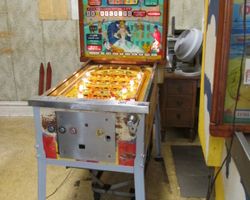Circus Queen
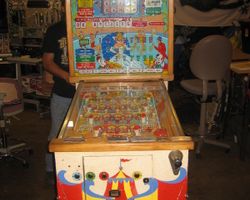
Average Prices: USD $400 to $1,200
Produced: 0
Machine Type: Electro-mechanical
Players: 1
Design by: Don Hooker
"Circus Queen," released by Bally Manufacturing Co. in December 1960, stands as a distinctive entry in the electro-mechanical (EM) era of pinball, specifically categorized as a bingo machine. At a time when Bally was beginning to diversify its production strategy beyond single-game releases, "Circus Queen" emerged, embodying the playful and captivating spirit of a classic circus. Its design was overseen by Don Hooker, a name associated with the intricate mechanics that defined many Bally titles of the period. This model, identified as #667, was part of a shift in Bally's manufacturing approach, as noted by a 1961 Billboard article, which highlighted the company's move towards varying its production line rather than adhering strictly to a one-game-at-a-time release schedule. "Circus Queen" was conceived as a "nickel machine," designed for quick, engaging play sessions often found in various public venues, reflecting a common economic model for arcade entertainment of the late 1950s and early 1960s. Its operation sometimes involved a unique payout system where an agent would visit locations to dispense winnings, usually in rolls of coins, splitting the remainder with the vendor. This business model underpinned the design philosophy of bingo pinball, where the objective extended beyond high scores to tangible rewards, fostering a different kind of engagement compared to traditional pinball machines.
Signature Features and Design
"Circus Queen" distinguishes itself through a set of features intricately tied to its bingo machine classification. Central to its allure are two dozen trap holes spread across the playfield, complemented by two rollover buttons. These elements are fundamental to determining the outcome of each ball's journey, influencing which numbers are lit on the backglass card. Beyond these standard interaction points, the machine introduces several standout mechanisms that elevate its unique gameplay. The "Magic Screen" feature, for instance, offered players an unpredictable element, potentially altering the game's progression in unexpected ways. The "OK Feature" presented another layer of strategic depth, allowing players to activate special conditions or bonuses during play. A "Blue bonus feature" further incentivized specific shots; balls landing in the blue-designated sections of the playfield would yield significantly higher scores, scoring 300 or 600 points, depending on the game state. Perhaps most indicative of its bingo heritage are the player-controlled number rearrangement buttons. These allowed players, after purchasing the feature, to manipulate the numbers displayed on the backglass card at critical junctures—before the fourth ball, before the fifth ball, or even after the fifth ball. This unprecedented level of player input over the outcome, a core mechanic of bingo machines, transformed the game from pure dexterity to a blend of skill, luck, and tactical decision-making, offering a distinct departure from conventional pinball design.
Playfield and Mechanics
The playfield of "Circus Queen" is a reflection of its circus and carnival theme, designed with an aesthetic that evokes the golden age of big-top entertainment. While specific ramps are not present in this EM design, the layout focuses on the strategic placement of its numerous trap holes and rollover buttons. These elements constitute the primary targets for the player's launched ball, each contributing to the lighting of numbers on the backglass. The flow of the playfield is less about high-speed ramp shots or intricate combos and more about precision and aiming for specific zones to achieve desired number combinations. The artwork, a vibrant tableau of circus performers and attractions, wraps the player in the machine's theme. Trapeze artists, clowns, and majestic animals adorn the backglass and playfield, rendered in the distinctive style of early 1960s pinball art. Lighting across the playfield and backglass serves to highlight activated numbers and special features, drawing the player's attention to the game's progression and potential payouts. The overall aesthetic is one of whimsical charm, aiming to immerse the player in the joyous, unpredictable atmosphere of a circus, where every roll of the ball could bring a new surprise.
Gameplay Dynamics
"Circus Queen" operates on a unique gameplay dynamic that intertwines manual dexterity with strategic number manipulation, a hallmark of bingo machines. The objective revolves around lighting specific patterns of numbers on the backglass "bingo card." Each ball launched onto the playfield, upon interacting with trap holes and rollover buttons, corresponds to a number being lit. The scoring system is intrinsically linked to these lit numbers and the formation of winning patterns, often with "odd up" features that could increase point values or potential payouts. The core challenge lies in directing the ball to activate the most beneficial numbers on the playfield. What truly distinguishes "Circus Queen" are its unique modes and objectives, particularly the ability to rearrange numbers on the backglass. This mechanic, purchased by the player, introduced a layer of real-time strategy. Players could analyze their current lit numbers and then, at opportune moments, press buttons to shuffle unlit numbers, hoping to create a more favorable alignment for a winning pattern with subsequent balls. This decision-making element transforms the game from a purely physical challenge into a mental one, where a player's ability to anticipate and adapt can significantly impact their chances. For instance, if a player had four numbers in a row lit and only needed one more in a specific column, they might use the rearrangement feature to try and bring a needed number into play. The "Magic Screen" and "OK Feature" added further layers of unpredictability and bonus opportunities, encouraging players to explore different shots and playfield interactions to trigger these special conditions, all contributing to the pursuit of a valuable bingo win.
Reception and Legacy
"Circus Queen," like many bingo machines of its era, holds a distinct place in pinball history. Feedback from those who experienced these machines often centers on a profound sense of nostalgia. Players who encountered "Circus Queen" during their youth, particularly in the late 1960s and early 1970s, fondly recall its unique appeal and the excitement of winning tangible sums from a "nickel machine." The game's straightforward approach to its core objective, combined with the thrill of the potential payout, resonated deeply with its audience. This direct connection to a tangible reward system fostered a different kind of player loyalty compared to machines focused purely on high scores.
One recurring sentiment regarding machines like "Circus Queen" is the difficulty in explaining their mechanics to contemporary pinball players. Modern machines often emphasize complex rule sets, multi-ball modes, and deep narrative progressions. In contrast, "Circus Queen," with its focus on lighting numbers, number rearrangement, and a payout system, operated under a different paradigm. This difference, however, is not a weakness but a reflection of its time and purpose. Its strengths lay in its immediate engagement, the simple satisfaction of hitting a target to light a number, and the strategic layer added by the number-shifting features. The overall sentiment surrounding "Circus Queen" is overwhelmingly positive, driven by the strong memories and foundational experiences it provided for a generation of players. It stands as an important example of Bally's innovative approach within the bingo machine segment, showcasing how they adapted the pinball form to suit a specific market demand. While not directly influencing traditional pinball machines with ramps and deep rule sets, "Circus Queen" and its bingo brethren carved out their own influential niche, demonstrating the diverse possibilities of electro-mechanical game design and forever cementing their role in the broader tapestry of coin-operated entertainment.
Sponsored Links
 Ebay Listings
Ebay Listings
 Auction Results
Auction Results
| Cost | Location | Date |
|---|---|---|
| USD $1,025 |  Illinois, United States Illinois, United States |
19 March, 2022 |
| USD $1,200 |  Illinois, United States Illinois, United States |
04 February, 2022 |
| GBP £500 |  Gloucester, United Kingdom Gloucester, United Kingdom |
01 April, 2020 |
| GBP £600 |  Shrewsbury, United Kingdom Shrewsbury, United Kingdom |
19 March, 2020 |
| USD $1,250 |  South Carolina, United States South Carolina, United States |
18 July, 2019 |
| USD $1,250 |  South Carolina, United States South Carolina, United States |
01 May, 2019 |
| USD $380 |  Washington, United States Washington, United States |
08 March, 2019 |
| GBP £980 |  Wolverhampton, United Kingdom Wolverhampton, United Kingdom |
07 December, 2015 |
| USD $370 |  Missouri, United States Missouri, United States |
18 July, 2015 |
| USD $250 |  Missouri, United States Missouri, United States |
24 June, 2015 |


Private Policy · Search Website · Contact Us
As an eBay Partner, we may earn a commission from qualifying purchases made through links on this site, at no additional cost to you.
All trademarks and copyrighted materials remain property of their respective owners. All other content copyright 2007 - 2025 Pinpedia.


